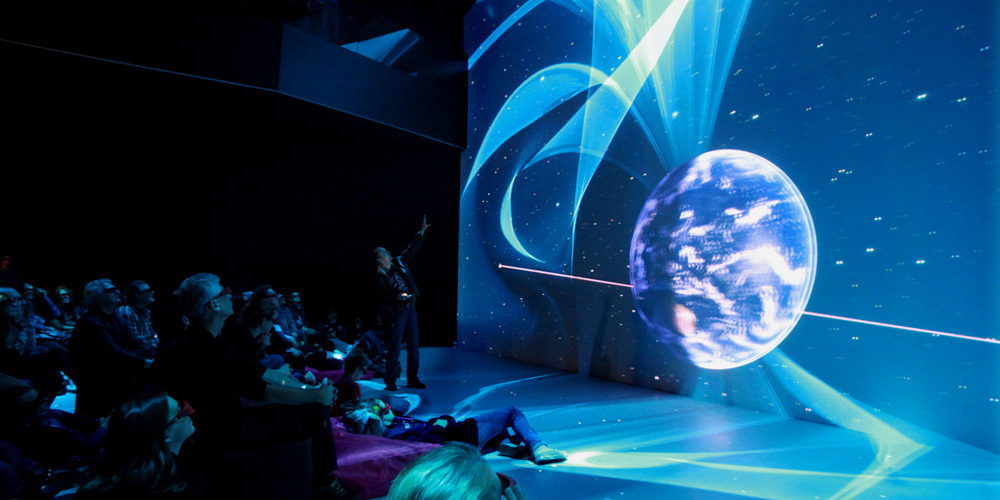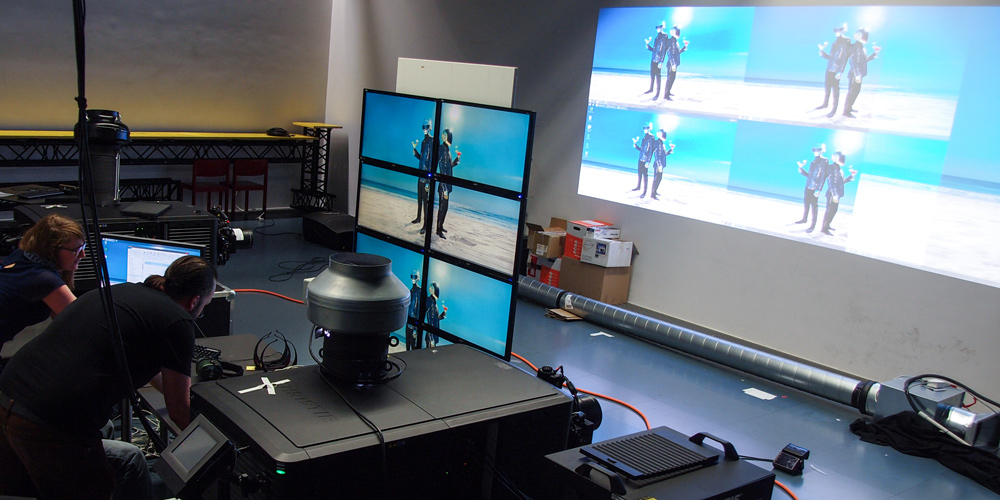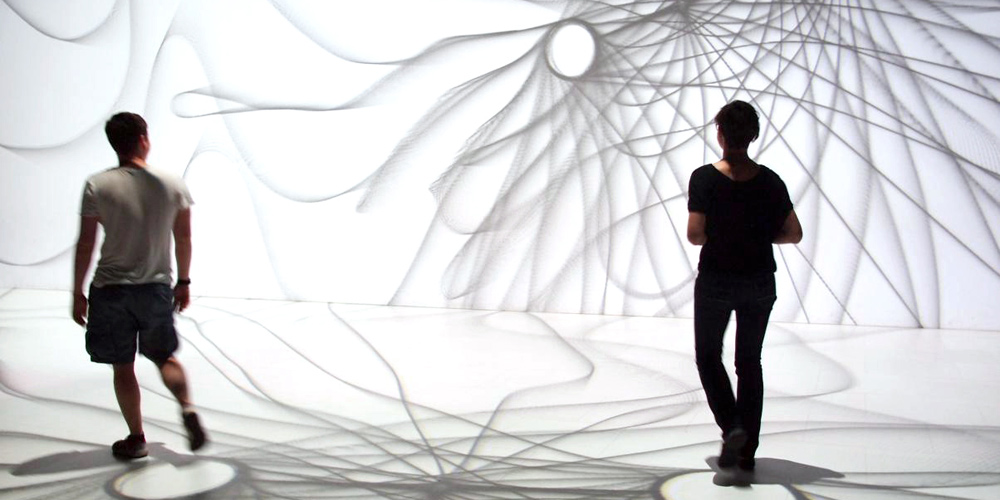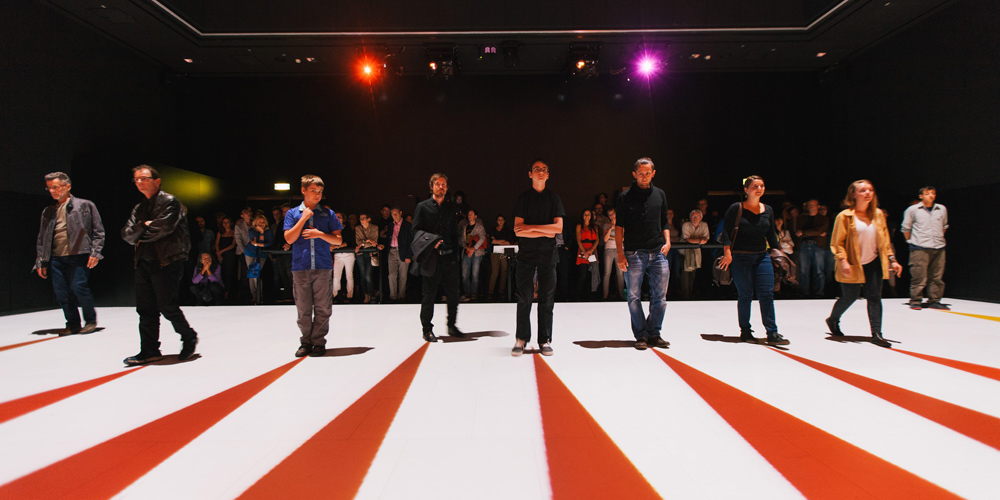Full HD and 4K—that’s yesterday’s news. 8K is what’s happening now, and that standard is set by the latest update to Deep Space at the Ars Electronica Center. A visit to Deep Space 8K promises to be extraordinary, fascinating, impressive, breathtaking—you can count on that! The “old” technology will remain in service at the Ars Electronica Center until July 10, 2015. The enhanced version of this incredible projection space premieres on August 7th. So, let’s take a closer look at the dramatic changes you’ll notice at Deep Space 8K.
What’s Deep Space? Whatever you say, don’t call it The Movies!
Since the expanded Ars Electronica Center debuted in 2009, this unique venue has been a favorite at the Museum of the Future. You feel it the moment you set foot inside Deep Space, where the wall as well as the floor are used as a projection surface, with each measuring in at an amazing 16×9 meters. Standing or sitting, visitors are in the middle of the action, and can even move around in virtual three-dimensional worlds.
As you can see, Deep Space isn’t a movie theater. It’s much more, and decidedly not a venue for run-of-the-mill motion pictures. A screening here is always a live performance in which an Infotrainer presents a selection of the wide-ranging material designed to take this technology to its limits. And no program has a preset sequence—visitors can play favorites and get a say in what they see.

A cosmic 3-D journey: in Deep Space 8K, the imagery is richer than ever. Photo: rubra
From ski slope to virtual lecture hall
As for content, Deep Space is unlimited. It can take visitors to any conceivable place, on Earth and beyond. You can watch a thrilling downhill run on Austria’s world-famous Streif from a ski racer’s perspective—don your 3-D glasses and off you go! Gigapixel images give you an ultra-close-up look at art treasures from the world’s great churches and museums—from the Kefermarkt Winged Altar to Leonardo da Vinci’s Mona Lisa. On Deep Space’s jumbo projection surfaces, works of media art such as prizewinning animated films singled out for recognition by the Prix Ars Electronica can impart their consummate visual fascination and transport spectators into futuristic, abstract, fairy-tale domains.
An audience favorite is the impressive journey through outer space. Taking leave of planet Earth, the itinerary includes the Sun, the Moon, the stars and the endless expanses of the known universe. In this awesome cosmos, we human beings are but tiny specks, but there’s nevertheless a lot to discover about us too. An amazing way to do it is by zooming in on the human body and beholding 3-D visualizations of the brain. These high-impact images turn the process of imparting knowledge into an unforgettable experience and bring out interrelationships in a way that really leaves an impression. As a virtual lecture hall, Deep Space is an unusual—and an unusually effective—environment for learning.

The Deep Space 8K project has already been in progress for several months. The hardware was first set up to run tests in the Ars Electronica Futurelab’s studio. Photo: Martin Hieslmair
So what’s new about Deep Space 8K?
At first glance, nothing. And yet, everything! The room looks like it did before: 16×9 meter projection surfaces on the wall and floor. But as soon as the visuals light up, the difference becomes obvious: images of unprecedented sharpness and intensity. All of Deep Space’s eight projectors—four each for the floor and wall—are being replaced by Christie Boxer 4K 30s a just-released model that delivers unrivaled performance when it comes to resolution and brightness. Projections in Deep Space 8K will now be four times more detailed than before. The number of pixels has been quadrupled! The bottom line: crystal-clear pictures and mind-blowing color intensity.
But new projection technology isn’t the whole story. This quantum leap has also necessitated a few background technical modifications. The huge quantities of data that make these pictures happen call for enormous computing power and a conduit to feed them into the projectors in a way that produces perfectly synchronized, flicker-free, 3-D images. The constellation of eight beamers powered by two processors by XI-MACHINES with four graphic cards each is not your common, everyday setup; thus, staffers from several of Ars Electronica’s divisions pooled their expertise to master the technical challenges posed by the implementation of this internationally unique project.

“Human Bodies: The Universe Within” was produced by the Ars Electronica Futurelab. Photo: Martin Hieslmair
Human Bodies: The Universe Within
Technically upgrading Deep Space also opens up interesting new possibilities with respect to the content screened in it. Since there isn’t much material available that fulfills these new technical and substantive specifications, Ars Electronica Futurelab has developed “Human Bodies: The Universe Within,” a comprehensive application that focuses on the human body and takes full advantage of Deep Space 8K’s capabilities. The extraordinarily high resolution brings out details that don’t suffer from diminished clarity, even when viewers get right up close. Fine lines, precision labeling, high-definition animation sequences and plenty of illustrations make Deep Space 8K’s depictions of the body as realistic as can be.
We developed material that portrays processes taking place in the human body and that’s designed to get across the inherent interrelationships in ways that make them easier to understand. Not only do the Ars Electronica Futurelab’s 3-D visualizations make it possible to illustrate the organs, bones, muscle fibers and blood vessels; thanks to the improved image resolution, graphics, texts and video sidebars can also be inserted into the presentation. Thus, the Infotrainers can combine various media elements—for example, to show how a sound makes its way from a visitor’s mouth through the auditory passageway to the brain of the transparent 3-D model of the human body.

“Sinus” by Simon Krenn is one of the many works developed in conjunction with the Deep Space course offered by Linz Art University. Photo: Martin Hieslmair
Playgrounds That Get Visitors in the Swing
The reconfigured Deep Space also opens up a whole series of portals to new content of impressive quality. Laser tracking is what enables media art projects and games developed especially for Deep Space to react to visitors’ movements. In “Sinus,” a work by Simon Krenn, a student in Linz Art University’s Time-based and Interactive Media program, visitors walk across the projection surface and—individually or as a group—impart vibrations to sine waves several meters in length. A special course offered this year by Linz Art University gave undergraduates the extraordinary opportunity to develop exhilarating interactive works for Deep Space. And students at the Upper Austria University of Applied Sciences’ Hagenberg Campus got a chance to work with the possibilities of laser tracking; the results include several games in which players have to bring their whole body into play.

Walk-through 3-D point clouds in Deep Space 8K. Photo: Martin Hieslmair, CyArk
Cultural Heritage in a Point Cloud
In order for humankind’s cultural heritage to be preserved for posterity—at least digitally—and to make it accessible to everyone, historical sites are recorded by means of 3-D laser scans. The resulting mass of data—a so-called point cloud—makes it possible to virtually depict statues, buildings or even an entire row of houses. The Ars Electronica Futurelab has developed a vastly improved point cloud renderer & viewer for Deep Space 8K. Now, for instance, the Maya city Tikal, a site that was previously digitized by the nonprofit organization CyArk, can be experienced as a 3-D visualization.

Photo: Thomas Schwarz
Time-lapse: Over the Course of Time
When phenomena that occur gradually in our world are captured in time-lapse imagery, the greatly accelerated pace makes them appear in a new light. A perfect example was shot in the immediate vicinity of the Ars Electronica Center—the transient light configurations, music and sound fragments that make up Thomas Schwarz‘s special acoustic and visual documentation of the Urfahr Fair. There’s a big repertoire of time-lapse videos made for Deep Space 8K. Footage of a day in Rio de Janeiro Janeiro gives spectators an up-close-and-personal look at this very diverse megacity. This is also a safe way to peer at the star our Earth orbits: over the course of five years, a NASA probe photographed the Sun several times per second and thus provided a wealth of material for a wonderful video about solar activity.
An Ars Electronica Festival Venue Opens on August 7, 2015
Deep Space in its present form will remain in service at the Ars Electronica Center Linz until July 10, 2015. The debut of Deep Space 8K will be hosted by Ars Electronica Artistic Director Gerfried Stocker on August 7th at 6:00 PM. Admission is free of charge. Horst Hörtner, director of the Ars Electronica Futurelab, and Andreas Bauer, director of the Ars Electronica Center, will offer a behind-the-scenes look at Deep Space 8K. And there’s a great program of activities lined up for the opening weekend, Saturday & Sunday, August 8-9 from 10 AM to 6 PM, when experts, scientists and artists will present some of the amazing new content developed for Deep Space 8K.
Additional 8K highlights are in store for visitors attending the Ars Electronica Festival, in Linz September 3-7, 2015, when the Ars Electronica Center’s Deep Space will be one of the prime venues. Details about the festival lineup will go online in mid-August at ars.electronica.art/postcity. In the meantime, this blog will keep you supplied with background stories and interviews about Deep Space 8K. So stop by again in a few days if you happen to be in the neighborhood. See ya!
Text: Kathrin Meyer and Martin Hieslmair
